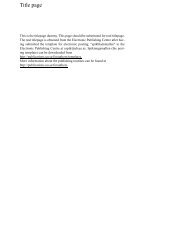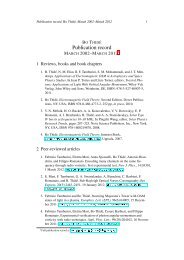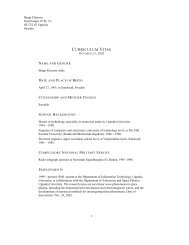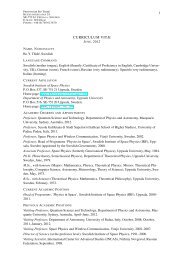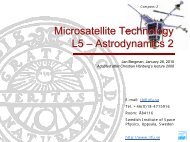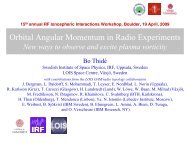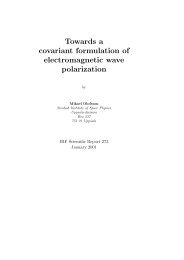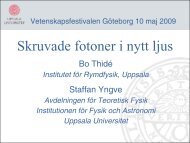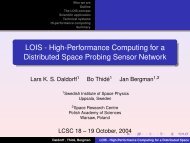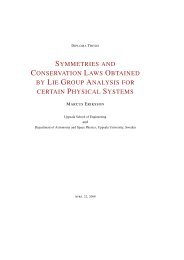Atmosphere-Ionosphere Mission - Swedish Institute of Space ...
Atmosphere-Ionosphere Mission - Swedish Institute of Space ...
Atmosphere-Ionosphere Mission - Swedish Institute of Space ...
Create successful ePaper yourself
Turn your PDF publications into a flip-book with our unique Google optimized e-Paper software.
SUMMARY 2<br />
1. Studies <strong>of</strong> the effects <strong>of</strong> controlled radio wave injections from purpose-built<br />
radio research facilities at various locations (Arecibo, Puerto Rico; HAARP,<br />
Gakona, Alaska; HIPAS, Chena Hot Springs, Alaska; EISCAT, Tromsø,<br />
Norway; SPEAR, Svalbard; Sura, Nizhniy Novgorod, Russia; LOIS, southern<br />
Sweden). Through laboratory-type experiments, a systematic mapping<br />
out <strong>of</strong> the fundamental underlying physical processes will be tried. The<br />
studies will include coupling mechanisms between the artificially perturbed<br />
lower ionosphere and the magnetosphere as well as the upper atmosphere.<br />
Particular attention will be paid to the role played by Alfvén waves in these<br />
processes.<br />
2. Studies <strong>of</strong> radiation-turbulence interactions above geographical regions with<br />
a high density <strong>of</strong> very powerful broadcast and TV stations (e.g., central<br />
Europe and the Far East). Comparisons with results obtained in step 1 are<br />
expected to reveal what impact man-made radio and TV transmissions have<br />
on the Earth’s space environment.<br />
3. Studies <strong>of</strong> EM radiation and interaction effects associated with thunderstorms,<br />
known to be frequent and to emit high powers <strong>of</strong> EM radiation and<br />
poorly understood associated phenomena such as sprites. The influence <strong>of</strong><br />
these natural perturbations will be compared with the man-made perturbations<br />
described in steps 1 and 2 to assess their relative importance and impact.<br />
These studies are probably best performed over the tropics.<br />
4. Studies <strong>of</strong> the Earth’s EM environment over pristine areas (e.g. the Pacific<br />
Ocean) where very few radio and TV stations are operated and thunderstorms<br />
are relatively rare. These measurements will be used as a reference against<br />
which the other measurements will be benchmarked.<br />
The <strong>Atmosphere</strong>-<strong>Ionosphere</strong> <strong>Mission</strong> is envisioned as a first in a series <strong>of</strong><br />
micro-satellites oriented toward ionosphere and upper atmosphere research with<br />
the objective to widen our knowledge <strong>of</strong> the intricate turbulent processes in this<br />
boundary region and, in the process, widen the space applications in Sweden by<br />
gradually including institutions which have not participated in space activities so<br />
far. These inexpensive platforms would serve also as testing facilities for new<br />
miniaturised devices and technologies.<br />
The proposed AIM project will consist <strong>of</strong> two satellites <strong>of</strong> the Astrid type in an<br />
elliptical orbit with a perigee <strong>of</strong> about 250–300 km and about 70 ◦ inclination. The<br />
apogee should be determined in such a way that the longevity <strong>of</strong> the mission is 6<br />
months or more. A mission with two satellites is important for scientific reasons,<br />
as it would make possible to resolve some problems related to spatio-temporal ambiguity<br />
discussed below. It would be also interesting and challenging for <strong>Swedish</strong><br />
space industry, which has a sufficient experience with deployment and management<br />
<strong>of</strong> single satellites.<br />
<strong>Atmosphere</strong>-<strong>Ionosphere</strong> <strong>Mission</strong><br />
Elaborate Science Case



